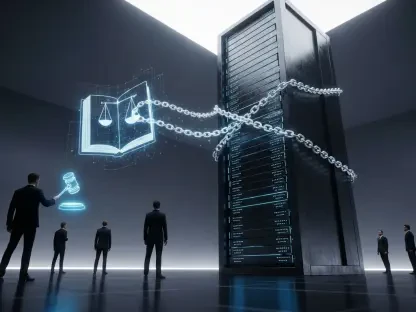Laurent Giraid offers insightful perspectives as a technologist specializing in Artificial Intelligence. His expertise stretches across machine learning and natural language processing, with particular attention to the ethical implications of AI. In this interview, Laurent explores the transformation of data engineering through rapid growth in business data and modern technological advancements. He illuminates how Large Language Models (LLMs) and Gen AI technology are reshaping processes, enhancing tasks such as data cleaning and integration, and addressing the disorder inherent in data engineering. Laurent also discusses the significance of the transformer architecture in LLMs and their potential benefits and limitations, providing valuable insights into the evolving landscape of data engineering.
How has the growth of business data transformed the field of data engineering?
The exponential growth in business data has reshaped data engineering significantly. It’s akin to navigating a vast ocean, where the sheer volume of data calls for new methods to manage, process, and analyze it effectively. Data engineers now focus more on scalability and agility, paving the way for more robust data infrastructures that can handle dynamic and complex data streams. This transformation has brought about a need for refined skills and innovative solutions, elevating the role of data engineers in driving business success.
What modern technology advancements have contributed to changes in data engineering?
Cloud computing, artificial intelligence, and serverless computing have revolutionized data engineering, each offering unique benefits. Cloud computing provides scalable resources and flexibility, allowing engineers to process massive datasets without the constraints of traditional in-house servers. Distributed computing systems enhance efficiency, enabling collaborative data processing across different geographical locations. Artificial intelligence brings an intelligent, predictive element to data management, automating many tasks that were previously manual and labor-intensive. Together, these technologies streamline operations and open up new possibilities for innovation in data engineering.
Why does data engineering naturally exist in disorder, and what challenges do data engineers face because of this?
Data engineering exists in disorder primarily due to the inherent complexity and variety of data sources. Data comes in different formats and structures, often lacking a standardized framework, which makes integration and analysis challenging. Engineers must navigate through this chaos to create coherent data systems. This disorder demands meticulous attention to detail and adaptability, as engineers must constantly work to harmonize disparate data sources while ensuring reliable and meaningful outputs. The main challenge is developing systems that can effectively clean, integrate, and process such varied data without falling prey to inaccuracies or inefficiencies.
What are Large Language Models (LLMs), and why are they causing a disruption in data engineering?
LLMs represent cutting-edge AI technologies that understand and generate human language, learning from vast text databases. This disruption comes from their ability to enhance and automate traditional data engineering tasks, offering unprecedented performance improvements and operational efficiencies. They intervene where visibility into data is lacking, making predictions and informed decisions possible even with limited data insights. Their impact is profound, as they allow data engineers to focus on more complex problem-solving while LLMs handle routine or structured tasks.
How do LLMs and Gen AI technology together improve data engineering performance and operational efficiency?
When combined, LLMs and Gen AI technology drastically boost data processing capabilities. They refine traditional tasks such as data cleaning and preprocessing, ensuring more precise outputs and streamlined workflows. By automating repetitive processes, they free up human resources to tackle strategic challenges. Moreover, they enhance performance by rapidly synthesizing insights and optimizing data use across various business operations. This synergy between LLMs and Gen AI technology leads to heightened agility and more informed decision-making, ultimately transforming how organizations leverage their data.
In scenarios lacking true data visibility, how can LLMs simplify data engineers’ work processes?
LLMs excel in scenarios where traditional methods struggle, particularly by offering solutions despite limited data visibility. They abstract subtle patterns and trends from non-traditional forms of data, enabling engineers to infer insights that would otherwise require extensive manual oversight. This capability allows engineers to bypass data gaps, predicting outcomes and generating valuable conclusions from incomplete data sets. Consequently, LLMs simplify complex processes, granting engineers the ability to focus their expertise on areas demanding human intuition and strategic foresight.
What tasks are LLMs capable of accomplishing in the realm of human language understanding and generation? Could you give some examples like writing essays or code generation?
LLMs serve versatile roles in understanding and generating human language. They’re adept at producing coherent narratives and structured reports, such as essays, and can craft technical documentation through code generation. Their contextual comprehension enables them to engage in meaningful conversations, draft emails, and perform translations. Within this realm, their function extends to creative and technical writing, supporting human effort with AI-driven efficiency, and enhancing productivity across diverse language-dependent tasks.
What is the importance of the transformer architecture in LLMs? Can you describe the roles of the encoder and decoder in transformer models?
The transformer architecture is pivotal in LLMs due to its ability to process sequential data relationships rapidly and accurately. It enables these models to detect contextual patterns, fundamental in understanding complex language structures. The encoder functions as a neural network that analyzes input text, generating hidden states rich in meaning and context. This information is then processed by the decoder, which predicts subsequent components of the output sequence, allowing the model to complete sentences or translate text while preserving coherence and relevance.
How do LLMs enhance traditional data engineering tasks such as data preprocessing and cleaning?
LLMs introduce efficiency and precision to data preprocessing and cleaning tasks, transforming traditionally labor-intensive procedures. Their ability to automate routine operations and handle unstructured data quickly reduces error rates and improves accuracy. By generating cleaned, structured data sets, LLMs enable clearer metrics for decision-makers, enhancing stakeholder understanding and facilitating easier queries. This automation not only saves time but also enhances the reliability and scalability of data operations.
What role do LLMs play in integrating and synthesizing datasets for business operations?
LLMs offer significant advantages in the integration and synthesis of datasets. They simplify complex data merging processes, identifying and connecting diverse data sources to uncover hidden insights. This capability allows businesses to harness the full potential of their data by creating comprehensive and enriched datasets. Moreover, LLMs facilitate agility in responding to data-driven demands, enabling seamless cross-domain analysis and empowering businesses with actionable insights.
How can LLMs improve data insights by working with a dataset that contains user location data?
LLMs can significantly enhance data insights by unifying and structuring user location data. For instance, in datasets with free-form user input, such as city names and state affiliations, LLMs can automate the transformation of disparate entries into cohesive structures. By harmonizing this data, they help ensure accurate geographical analyses and can identify new trends or patterns within location-based data sets. This leads to more informed decisions concerning regional market strategies and customer behavior insights.
In what ways can LLMs help in identifying anomalies and inconsistencies in data?
Utilizing natural language processing capabilities, LLMs excel at detecting anomalies and inconsistencies within large datasets. They identify outliers, errors, and missing values, in part through context comprehension, ensuring the integrity and reliability of data. By automating these checks, LLMs reduce the burdens associated with manual data inspection, enabling quicker identification and resolution of potential issues. This proactive anomaly detection supports continuous data quality improvement, enhancing overall data-driven decision-making.
How do LLMs retrieve hidden data from large datasets more efficiently than manual processing?
LLMs outperform manual processing through their ability to discern and extract pertinent data swiftly and accurately. They leverage context-awareness to draw insights from multimodal datasets—whether text, audio, or video. This capability allows teams to process and retrieve information without the tedious manual intervention, saving considerable time and resources. Their contextual understanding aids in unveiling hidden patterns, correlations, and insights that might elude human analysts, thereby optimizing operational efficiency.
What are some examples of routine operations that LLMs can automate for data engineers?
LLMs automate various repetitive tasks that data engineers typically encounter. These include normalizing data entries, parsing HTML files for product comparisons, summarizing lengthy documents, and transforming raw data into structured formats. By offloading such operations, LLMs allow engineers to focus on higher-level analytical challenges. This automation not only expedites project timelines but also ensures consistency and accuracy across continuous data engineering tasks.
What are the potential benefits of incorporating LLMs into a company’s data analytics roadmap?
Integrating LLMs into a company’s data analytics roadmap can yield transformative benefits. They accelerate data processing, enhance quality through consistent cleaning and preprocessing, and boost analytical capabilities by synthesizing valuable insights across domains. This integration aligns with strategic innovation goals, fostering a data-driven environment that supports rapid decision-making and agile responses to market changes. Companies can leverage LLMs for improved efficiency and enhanced competitive advantages, positioning themselves at the forefront of AI-driven business intelligence.
What limitations do LLMs have in data engineering, and why is human oversight necessary?
While LLMs provide significant advantages, they possess limitations such as misinterpretation of context and potential bias in generated outputs. These weaknesses necessitate vigilant human oversight to verify accuracy and ensure ethical practices in data engineering applications. Data engineers must bring their domain knowledge and critical thinking skills to assess and confirm AI outputs, maintaining control over data pipelines and safeguarding the integrity of the information processed.
How might the initial adoption of LLMs in data engineering impact the field as AI becomes more widespread across industries?
Introducing LLMs into data engineering marks a pivotal shift, offering efficiencies that redefine traditional operations. As AI proliferation accelerates, the field will undergo significant transformations, with LLMs reducing manual complexity and enhancing automation. This adoption could lead to a stronger emphasis on strategic thinking, as engineers focus on leveraging insights derived from AI-processed data. As industries embrace AI, data engineering evolves into a more intelligent and integral component of overall business strategy, enhancing capability and innovation across sectors.









